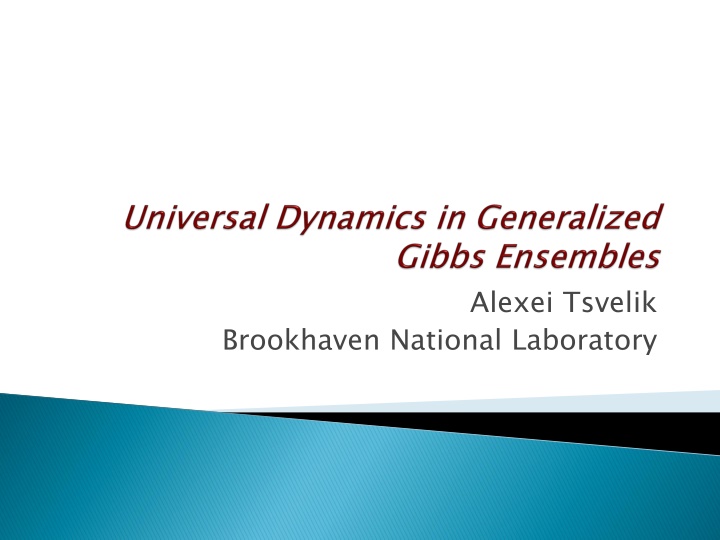
Universal Behavior in 1D Integrable Systems Subject to Sudden Changes
Explore the intriguing behavior of 1D integrable systems when subjected to sudden changes, leading to universal properties and emergent phenomena. From the path to universality through Lie group symmetry to the emergence of Lorentz invariance at low energies, delve into the world of integrability and universal actions. Witness how the Bethe Ansatz equations govern excitations and the distribution functions of roots in this fascinating realm of theoretical physics.
Uploaded on | 0 Views
Download Presentation

Please find below an Image/Link to download the presentation.
The content on the website is provided AS IS for your information and personal use only. It may not be sold, licensed, or shared on other websites without obtaining consent from the author. If you encounter any issues during the download, it is possible that the publisher has removed the file from their server.
You are allowed to download the files provided on this website for personal or commercial use, subject to the condition that they are used lawfully. All files are the property of their respective owners.
The content on the website is provided AS IS for your information and personal use only. It may not be sold, licensed, or shared on other websites without obtaining consent from the author.
E N D
Presentation Transcript
Alexei Tsvelik Brookhaven National Laboratory
Imagine 1D integrable system subject to a sudden change of H. Even if the system was initially in the ground state, after this change it becomes a superposition of states with oscillatory exponents: After a period of time the oscillatory exponents cancel each other and diagonal density matrix remains. Conjecture: Ii integrals of motion (including energy)
T is temperature for the I1 =E, in what follows I fix = . It will be assumed that all integrals of motion are finite which can occur only if the change excites particles in a limited range of momenta. The universality occurs when T << energy density.
The path to universality: Integrability, Lie group symmetry. The result: for all models possessing these properties the low-T spin dynamics is determined by a universal action of a ferromagnet defined on the corresponding group. The low energy modes have spectrum. energy density
Lorentz invariance emerges at low energies when one linearizes the spectrum: This effective low energy theory is called Chiral Gross-Neveu model:
Excitations: are gapless phasons and massive (gapful) particles transforming according to Bethe Ansatz equations for the massive sector Crucial fact: integrals do not depend on auxiliary parameters
In this limit the spectrum coincides with the one of spin sectror of SU(2) Chiral Gross-Neveu. The Bethe Ansatz: The integrals of motion depend on only:
When the energy density ~ L, solutions of BA eq-ns group into strings: Roots of BA eq-ns are described by distribution functions of occupied and unoccupied roots :
Equations for density distribution functions: One minimizes the free energy with respect to n to obtain equations for excitation energies: The key feature: the driving term K is present in ONE equation only. Thus one can declare fixed.
Equations for n=1,2, include only positive energies : Invert the kernel: In the limit T=0 the excitation energies are
In order for free energy to be finite, () must have a finite support
In the low-T limit the TBA equations for the spin sector are exactly like TBA for a spin S=1/2 ferromagnet at thermodynamic equilibrium: on a lattice Are energy and momenta of n- magnon bound states.
